Assessment of the Streamflow and Evapotranspiration at Wabiga Juba Basin Using a Water Evaluation and Planning (WEAP) Model
Abstract
1. Introduction
2. Methodology
2.1. Study Area and Data Collection
2.2. The WEAP Model Performance
2.2.1. Nash–Sutcliffe Efficiency (NSE)
2.2.2. Percent Bias (PBIAS)
2.2.3. Coefficient of Determination
- = is observed discharge;
- = is simulated discharge;
- = is mean of the observed discharge;
- = is the mean of the simulated discharge.
2.2.4. Validation and Classification Criteria
3. Results and Discussion
3.1. Hydrologic Model Development: WEAP
3.2. The WEAP Model Performance: Validation and Classification Criteria
4. Conclusions
Author Contributions
Funding
Data Availability Statement
Acknowledgments
Conflicts of Interest
References
- Farrokhzadeh, S.; Monfared, S.A.H.; Azizyan, G.; Shahraki, A.S.; Ertsen, M.W.; Abraham, E. Sustainable Water Resources Management in an Arid Area Using a Coupled Optimization-Simulation Modeling. Water 2020, 12, 885. [Google Scholar] [CrossRef]
- Ghanim, A.A.J.; Beddu, S.; Abd Manan, T.S.B.; Al Yami, S.H.; Irfan, M.; Mursal, S.N.F.; Mohd Kamal, N.L.; Mohamad, D.; Machmudah, A.; Yavari, S.; et al. Prediction of Runoff in Watersheds Located within Data-Scarce Regions. Sustainability 2022, 14, 7986. [Google Scholar] [CrossRef]
- Moriasi, D.N.; Gitau, M.W.; Pai, N.; Daggupati, P. Hydrologic and Water Quality Models: Performance Measures and Evaluation Criteria. Am. Soc. Agric. Biol. Eng. 2015, 58, 1763–1785. [Google Scholar]
- Mounir, Z.M.; Ma, C.M.; Amadou, I. Application of Water Evaluation and Planning (WEAP): A Model to Assess Future Water Demands in the Niger River (In Niger Republic). Math. Model. Methods Appl. Sci. 2011, 5, 38–49. [Google Scholar] [CrossRef]
- Fowler, H.J.; Kilsby, C.G.; O’Connell, P.E. Modeling the impacts of climatic change and variability on the reliability, resilience, and vulnerability of a water resource system. Water Resour. Res. 2003, 39, 1222. [Google Scholar] [CrossRef]
- Christensen, N.S.; Wood, A.W.; Voisin, N.; Lettenmaier, D.P.; Palmer, R.N. The effects of climate change on the hydrology and water resources of the Colorado River basin. Clim. Chang. 2004, 62, 337–363. [Google Scholar] [CrossRef]
- Tena, T.M.; Nguvulu, A.; Mwelwa, D.; Mwaanga, P.; Tena, T.M.; Nguvulu, A.; Mwelwa, D.; Mwaanga, P. Assessing Water Availability and Unmet Water Demand Using the WEAP Model in the Semi-Arid Bweengwa, Kasaka and Magoye Sub-Catchments of Southern Zambia. J. Environ. Prot. 2021, 12, 280–295. [Google Scholar] [CrossRef]
- Mourad, K.A. A Water Compact for Sustainable Water Management. Sustainability 2020, 12, 7339. [Google Scholar] [CrossRef]
- Jama, A.A.; Mourad, K.A. Water Services Sustainability: Institutional Arrangements and Shared Responsibilities. Sustainability 2019, 11, 916. [Google Scholar] [CrossRef]
- Mohamed, A.E. Managing Shared Basins in the Horn of Africa—Ethiopian Projects on the Juba and Shabelle Rivers and Downstream Effects in Somalia. Nat. Resour. Conserv. 2013, 1, 35–49. [Google Scholar]
- Houghton-Carr, H.A.; Print, C.R.; Fry, M.J.; Gadain, H.; Muchiri, P. An assessment of the surface water resources of the Juba-Shabelle basin in southern Somalia. Hydrol. Sci. J. 2011, 56, 759–774. [Google Scholar] [CrossRef]
- Basnyat, D.B.; Gadain, H.M. Hydraulic Analysis of Rivers Juba and Shabelle in Somalia Basic Analysis for Irrigation and Flood Management Purposes; Technical Report No W-13; FAO-SWALIM: Nairobi, Kenya, 2009. [Google Scholar]
- Salman, S.M.A. The Baardhere Dam and Water Infrastructure Project in Somalia—Ethiopia’s objection and the World Bank response. Hydrol. Sci. J. 2011, 56, 630–640. [Google Scholar] [CrossRef]
- Abera Abdi, D.; Ayenew, T. Evaluation of the WEAP model in simulating subbasin hydrology in the Central Rift Valley basin, Ethiopia. Ecol. Process. 2021, 10, 41. [Google Scholar] [CrossRef]
- Jha, M.K.; Gupta, A. Das Application of Mike Basin for Water Management Strategies in a Watershed. Water Int. 2009, 28, 27–35. [Google Scholar] [CrossRef]
- Vieira, E.d.O.; Sandoval-Solis, S. Water resources sustainability index for a water-stressed basin in Brazil. J. Hydrol. Reg. Stud. 2018, 19, 97–109. [Google Scholar] [CrossRef]
- Yates, D.; Sieber, J.; Purkey, D.; Huber-Lee, A. WEAP21—A Demand-, Priority-, and Preference-Driven Water Planning Model. Water Int. 2009, 30, 487–500. [Google Scholar] [CrossRef]
- Labadie, J.W. MODSIM: Decision Support System for Integrated River Basin Management. In Proceedings of the International Congress on Environmental Modelling and Software, Burlington, VT, USA, 9–13 July 2006; pp. 1–11. [Google Scholar]
- Assaf, H.; van Beek, E.; Borden, C.; Gijsbers, P.; Jolma, A.; Kaden, S.; Kaltofen, M.; Labadie, J.W.; Loucks, D.P.; Quinn, N.W.T.; et al. Chapter Thirteen Generic Simulation Models for Facilitating Stakeholder Involvement in Water Resources Planning and Management: A Comparison, Evaluation, and Identification of Future Needs. Dev. Integr. Environ. Assess. 2008, 3, 229–246. [Google Scholar] [CrossRef]
- Dehghanipour, A.H.; Zahabiyoun, B.; Schoups, G.; Babazadeh, H. A WEAP-MODFLOW surface water-groundwater model for the irrigated Miyandoab plain, Urmia lake basin, Iran: Multi-objective calibration and quantification of historical drought impacts. Agric. Water Manag. 2019, 223, 105704. [Google Scholar] [CrossRef]
- de Salis, H.H.C.; da Costa, A.M.; Vianna, J.H.M.; Schuler, M.A.; Künne, A.; Fernandes, L.F.S.; Pacheco, F.A.L. Hydrologic Modeling for Sustainable Water Resources Management in Urbanized Karst Areas. Int. J. Environ. Res. Public Health 2019, 16, 2542. [Google Scholar] [CrossRef]
- Tena, T.M.; Mwaanga, P.; Nguvulu, A. Hydrological Modelling and Water Resources Assessment of Chongwe River Catchment using WEAP Model. Water 2019, 11, 839. [Google Scholar] [CrossRef]
- Singh, M.; Shinde, V.; Pradhan, S.K.; Chalodiya, A.L.; Shukla, K.N. Hydrologic Modelling of Mahanadi River Basin in India Using Rainfall-Runoff Model. Nat. Environ. Pollut. Technol. 2014, 13, 385–392. [Google Scholar]
- Teklu, S.; Soliman, A.H.; El-Zawahry, A. Planning for Environmental Water Allocations: Hydrology—Based Assessment in the Awash River Basin, Ethiopia. J. Environ. Earth Sci. 2019, 9, 78–87. [Google Scholar] [CrossRef]
- Khalil, A.; Rittima, A.; Phankamolsil, Y. The projected changes in water status of the Mae Klong Basin, Thailand, using WEAP model. Paddy Water Environ. 2018, 16, 439–455. [Google Scholar] [CrossRef]
- Maliehe, M.; Mulungu, D.M.M. Assessment of water availability for competing uses using SWAT and WEAP in South Phuthiatsana catchment, Lesotho. Phys. Chem. Earth 2017, 100, 305–316. [Google Scholar] [CrossRef]
- Desta, H.; Lemma, B.; Gebremariam, E. Identifying sustainability challenges on land and water uses: The case of Lake Ziway watershed, Ethiopia. Appl. Geogr. 2017, 88, 130–143. [Google Scholar] [CrossRef]
- Yaykiran, S.; Cuceloglu, G.; Ekdal, A. Estimation of Water Budget Components of the Sakarya River Basin by Using the WEAP-PGM Model. Water 2019, 11, 271. [Google Scholar] [CrossRef]
- Asghar, A.; Iqbal, J.; Amin, A.; Ribbe, L. Integrated hydrological modeling for assessment of water demand and supply under socio-economic and IPCC climate change scenarios using WEAP in Central Indus Basin. J. Water Supply Res. Technol. AQUA 2019, 68, 136–148. [Google Scholar] [CrossRef]
- Mab, P.; Kositsakulchai, E. Water Balance Analysis of Tonle Sap Lake using WEAP Model and Satellite-Derived Data from Google Earth Engine. Sci. Technol. Asia 2020, 25, 45–58. [Google Scholar] [CrossRef]
- Kirkham, M.B. Potential Evapotranspiration. Princ. Soil Plant Water Relat. 2005, 455–468. [Google Scholar] [CrossRef]
- Röske, F. A global heat and freshwater forcing dataset for ocean models. Ocean Model. 2006, 11, 235–297. [Google Scholar] [CrossRef]
- Chiew, F.; McMahon, T. Application of the daily rainfall-runoff model MODHYDROLOG to 28 Australian catchments. J. Hydrol. 1994, 153, 383–416. [Google Scholar] [CrossRef]
- Zhu, Y.; Shan, D.; Wang, B.; Shi, Z.; Yang, X.; Liu, Y. Floristic features and vegetation classification of the Hulun Buir Steppe in North China: Geography and climate-driven steppe diversification. Glob. Ecol. Conserv. 2019, 20, e00741. [Google Scholar] [CrossRef]
- Aboelsoud, H.M.; Habib, A.; Engel, B.; Hashem, A.A.; El-Hassan, W.A.; Govind, A.; Elnashar, A.; Eid, M.; Kheir, A.M.S. The combined impact of shallow groundwater and soil salinity on evapotranspiration using remote sensing in an agricultural alluvial setting. J. Hydrol. Reg. Stud. 2023, 47, 101372. [Google Scholar] [CrossRef]
- Dass, B.; Daniel, D.; Saxena, N.; Sharma, A.; Sen, D.; Sen, S. Informing watershed management in data-scarce Indian Himalayas. Water Secur. 2023, 19, 100138. [Google Scholar] [CrossRef]
- Hund, S.V.; Allen, D.M.; Morillas, L.; Johnson, M.S. Groundwater recharge indicator as tool for decision makers to increase socio-hydrological resilience to seasonal drought. J. Hydrol. 2018, 563, 1119–1134. [Google Scholar] [CrossRef]
- Orkodjo, T.P.; Kranjac-Berisavijevic, G.; Abagale, F.K. Impact of climate change on future availability of water for irrigation and hydropower generation in the Omo-Gibe Basin of Ethiopia. J. Hydrol. Reg. Stud. 2022, 44, 101254. [Google Scholar] [CrossRef]
- Dutta, D.; Vaze, J.; Kim, S.; Hughes, J.; Yang, A.; Teng, J.; Lerat, J. Development and application of a large scale river system model for National Water Accounting in Australia. J. Hydrol. 2017, 547, 124–142. [Google Scholar] [CrossRef]
- Lei, T.; Pang, Z.; Wang, X.; Li, L.; Fu, J.; Kan, G.; Zhang, X.; Ding, L.; Li, J.; Huang, S.; et al. Drought and Carbon Cycling of Grassland Ecosystems under Global Change: A Review. Water 2016, 8, 460. [Google Scholar] [CrossRef]
- Watkins, J.R. The definition of the terms hydrologically arid and humid for Australia. J. Hydrol. 1969, 9, 167–181. [Google Scholar] [CrossRef]
- Jiang, Y.; Xu, Z.; Xiong, L. Runoff variation and response to precipitation on multi-spatial and temporal scales in the southern Tibetan Plateau. J. Hydrol. Reg. Stud. 2022, 42, 101157. [Google Scholar] [CrossRef]
- Murphy, K.W.; Ellis, A.W. An assessment of the stationarity of climate and stream flow in watersheds of the Colorado River Basin. J. Hydrol. 2014, 509, 454–473. [Google Scholar] [CrossRef]
- Waterman, B.R.; Alcantar, G.; Thomas, S.G.; Kirk, M.F. Spatiotemporal variation in runoff and baseflow in watersheds located across a regional precipitation gradient. J. Hydrol. Reg. Stud. 2022, 41, 101071. [Google Scholar] [CrossRef]
- Candela, L.; Tamoh, K.; Olivares, G.; Gomez, M. Modelling impacts of climate change on water resources in ungauged and data-scarce watersheds. Application to the Siurana catchment (NE Spain). Sci. Total Environ. 2012, 440, 253–260. [Google Scholar] [CrossRef] [PubMed]
- Kusahara, K.; Williams, G.D.; Massom, R.; Reid, P.; Hasumi, H. Roles of wind stress and thermodynamic forcing in recent trends in Antarctic sea ice and Southern Ocean SST: An ocean-sea ice model study. Glob. Planet. Chang. 2017, 158, 103–118. [Google Scholar] [CrossRef]
- Ho, L.T.; Goethals, P.L.M. Opportunities and Challenges for the Sustainability of Lakes and Reservoirs in Relation to the Sustainable Development Goals (SDGs). Water 2019, 11, 1462. [Google Scholar] [CrossRef]
- Chisola, M.N.; Kuráž, M. Patterns and Implications of Hydrologic Regime Change in Chongwe River, Zambia. J. Geogr. Geol. 2016, 8, p1. [Google Scholar] [CrossRef]
- Legesse, D.; Vallet-Coulomb, C.; Gasse, F. Hydrological response of a catchment to climate and land use changes in Tropical Africa: Case study South Central Ethiopia. J. Hydrol. 2003, 275, 67–85. [Google Scholar] [CrossRef]
- Duru, U.; Arabi, M.; Wohl, E.E. Modeling stream flow and sediment yield using the SWAT model: A case study of Ankara River basin, Turkey. Phys. Geogr. 2017, 39, 264–289. [Google Scholar] [CrossRef]
- Güngör, Ö.; Göncü, S. Application of the soil and water assessment tool model on the Lower Porsuk Stream Watershed. Hydrol. Process. 2013, 27, 453–466. [Google Scholar] [CrossRef]
- Hamlat, A.; Guidoum, A. Assessment of groundwater quality in a semiarid region of Northwestern Algeria using water quality index (WQI). Appl. Water Sci. 2018, 8, 220. [Google Scholar] [CrossRef]
- Ingol-Blanco, E.; McKinney, D.C. Development of a Hydrological Model for the Rio Conchos Basin. J. Hydrol. Eng. 2013, 18, 340–351. [Google Scholar] [CrossRef]
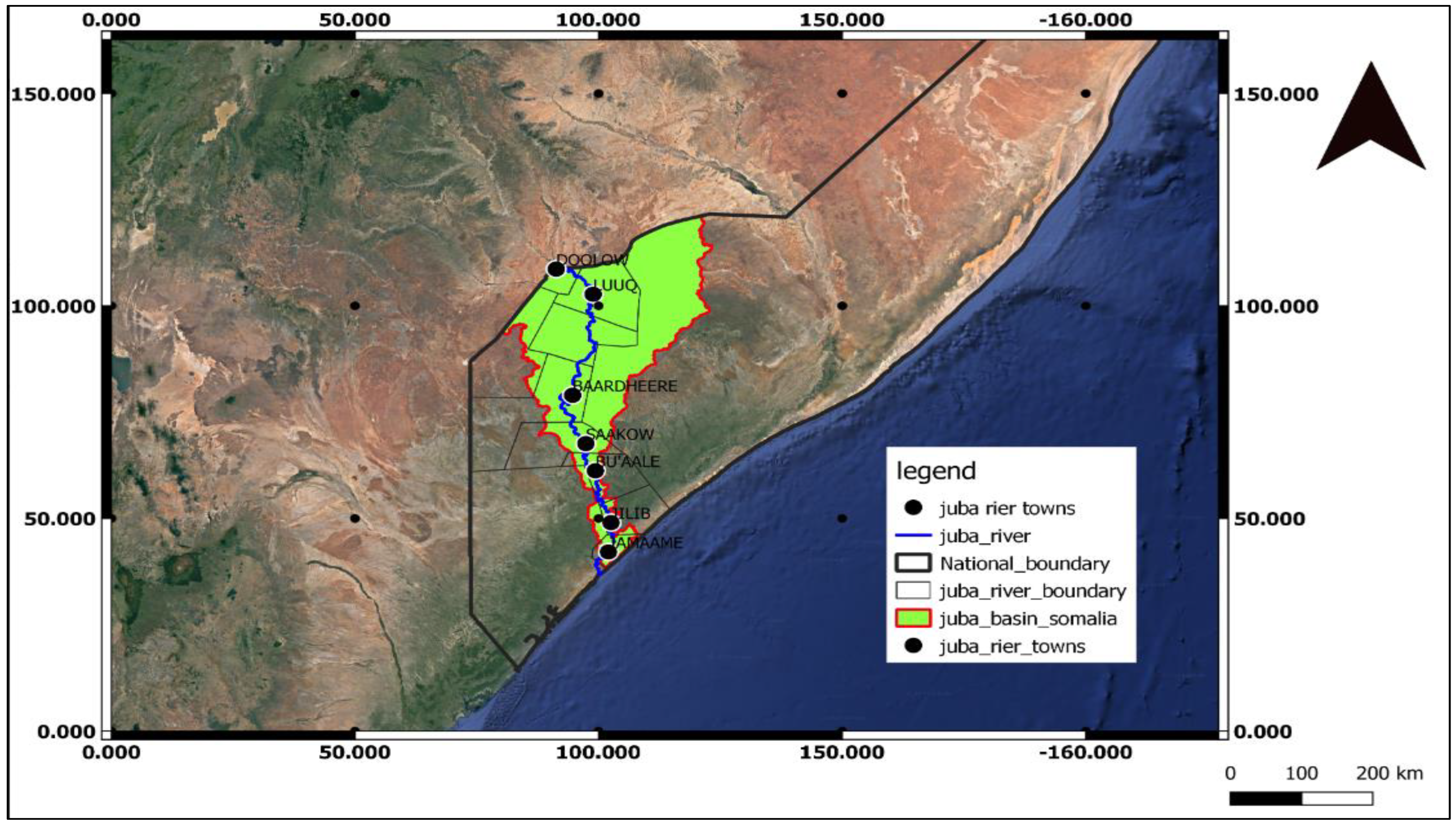
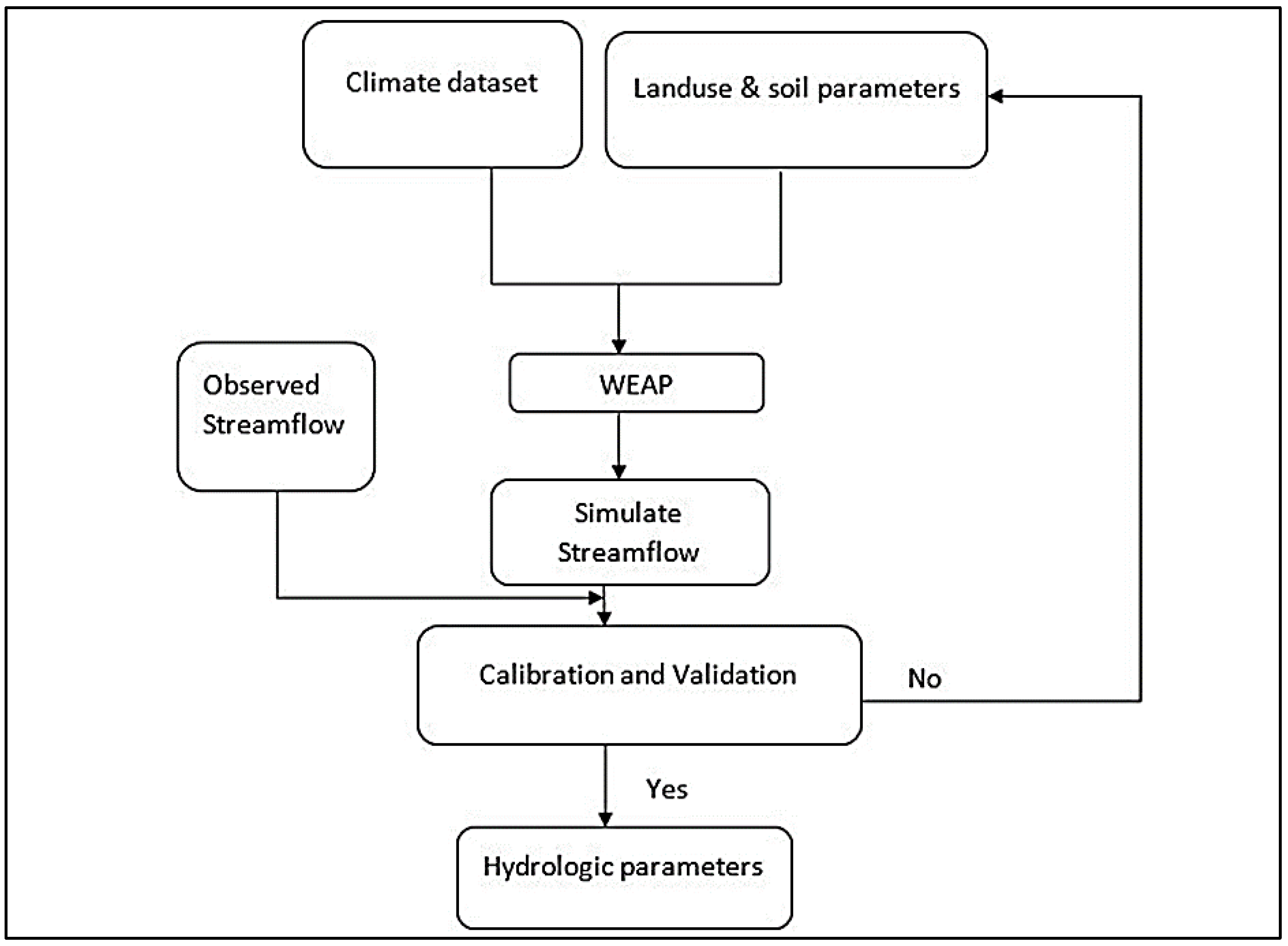

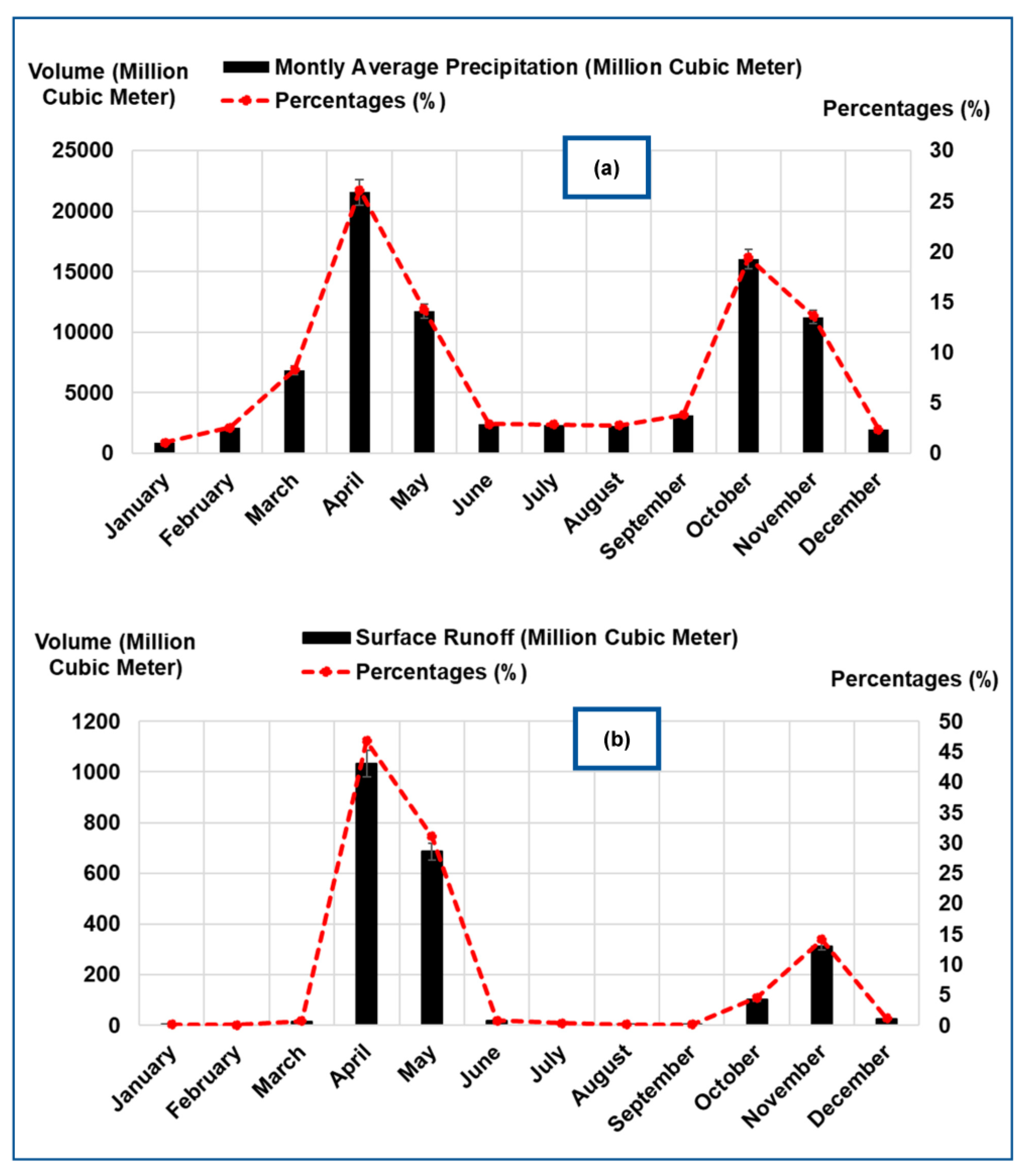
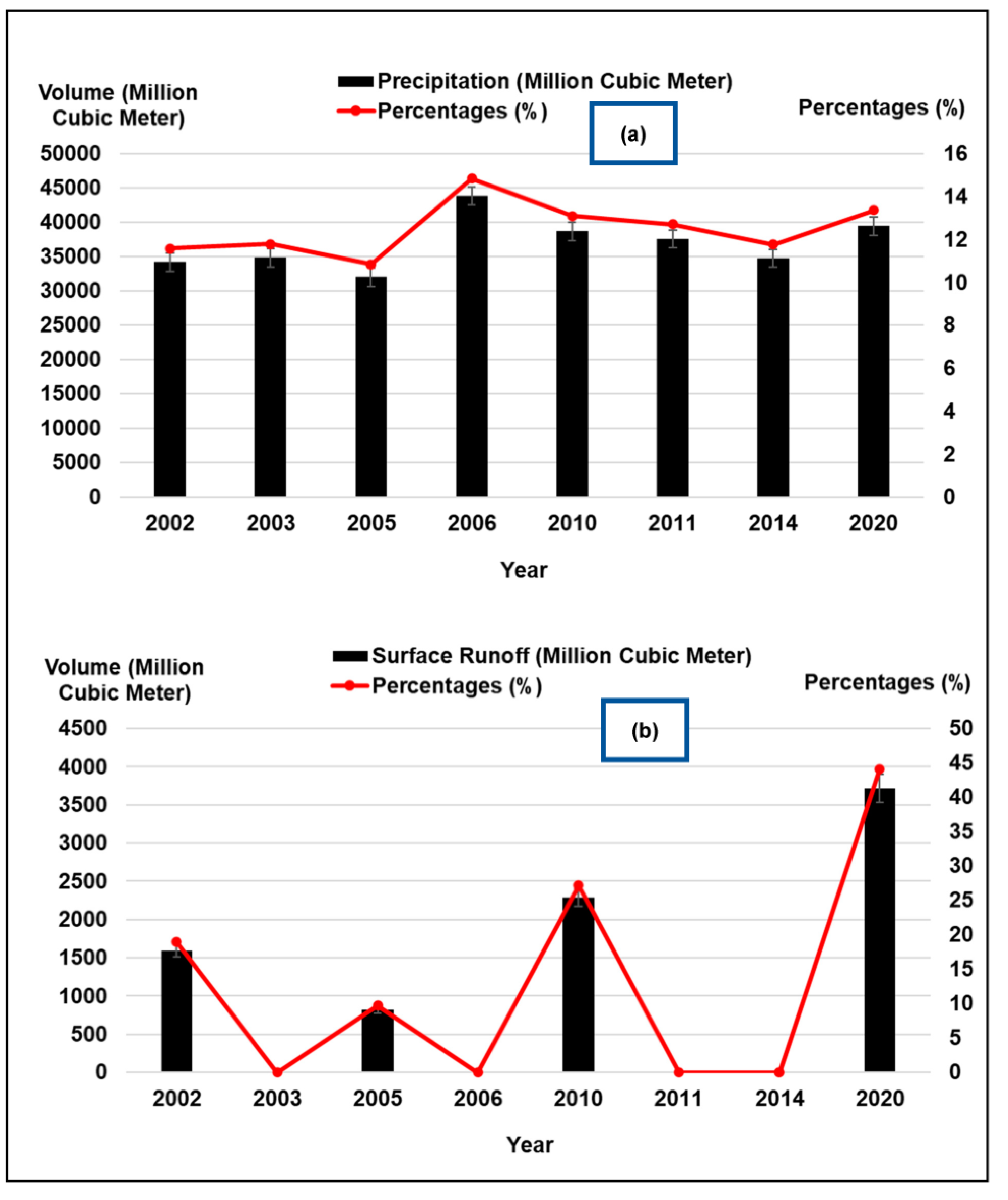
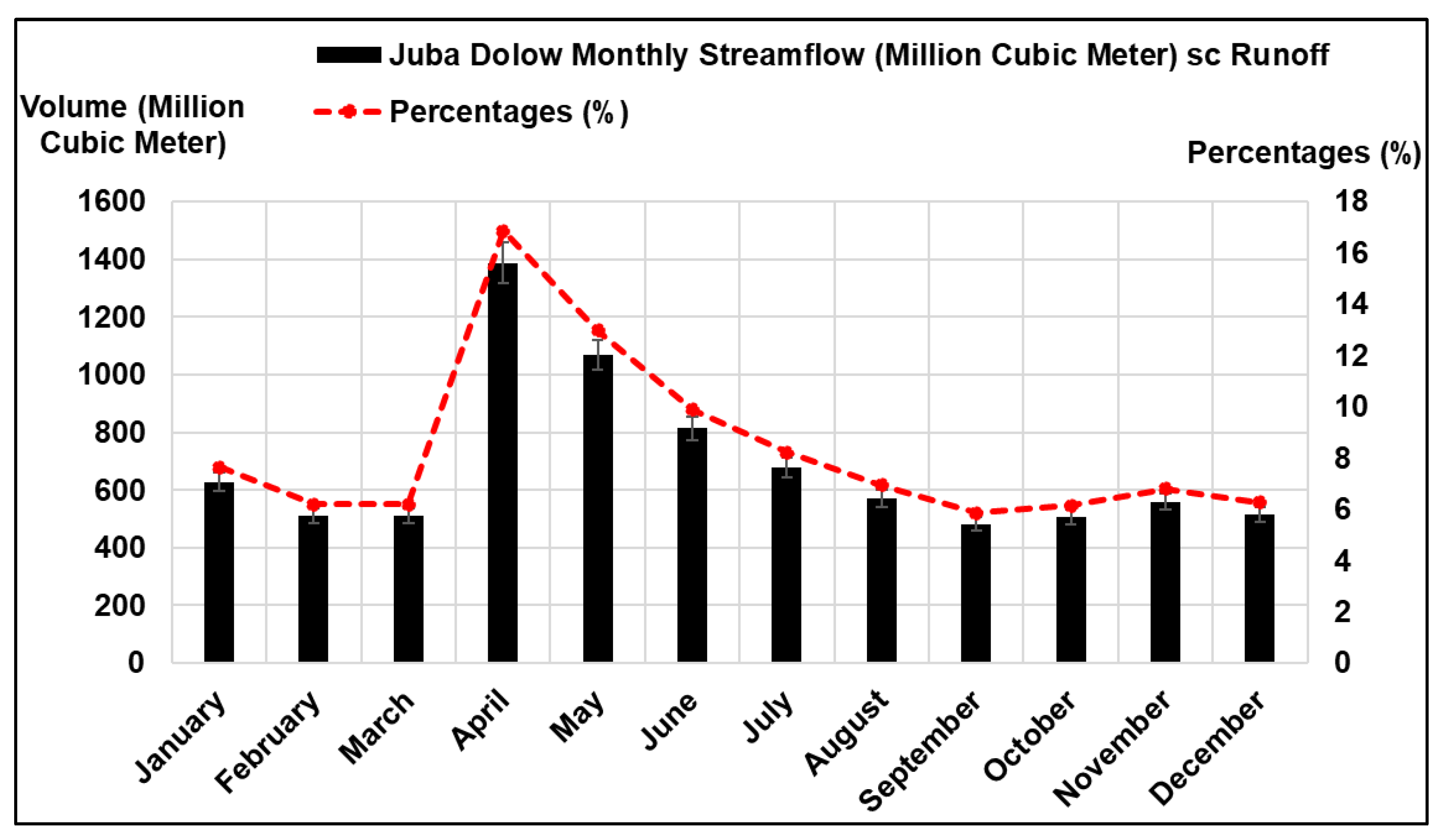
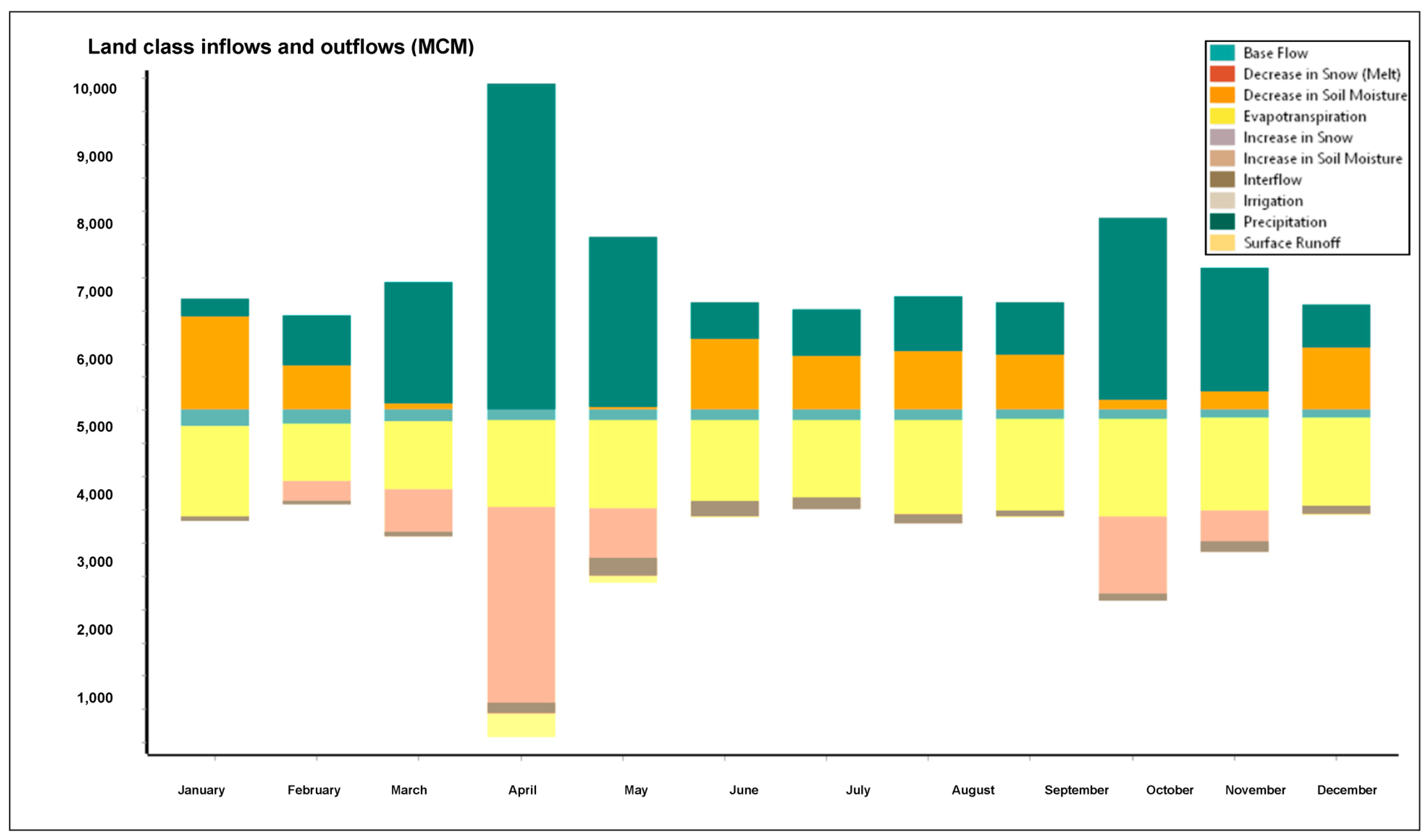

| Hydrological Model(s) | Research Focus | Approach | Simulation Method | Model Performance | Basin and Location | |
|---|---|---|---|---|---|---|
| Physical Model | Statistical Model | |||||
| WEAP | Water resources | √ | √ | Soil moisture method | R2 = 0.97 NSE = 0.64 | Chongwe River Catchment (Zambia) [22] |
| WEAP | Sub-basin hydrology | √ | √ | Soil moisture method | R2 = 0.82 NSE =0.80 | Central Rift Valley basin (Ethiopia) [31] |
| WEAP | Hydrologic simulation | √ | √ | Soil moisture rainfall–runoff method | R2 = 0.88 NSE = 0.86 PBIAS = −16.5 | Awash basin (Ethiopia) [24] |
| WEAP | Evaluating the current availability of water resources | √ | √ | Simplified coefficient method | R2 = 0.91 NSE = 0.89 PBIAS = −10.7 | Mae Klong (Thailand) [25] |
| WEAP & SWAT | Assessing the quantity of surface water | √ | √ | Allocated the resources in the catchment | R2 = 0.64 NSE = 0.73 | South Phuthiasana (Tanzania) [26] |
| SWAT | Assessing the current status of Lake Ziway and its watershed from hydrological point of view | √ | √ | WEAP-PGM | R2 = 0.6 NSE = 0.55 | Lake Ziway (Ethiopia) [27] |
| WEAP | Estimating the water budget components of the Sakarya River basin on annual basis | √ | √ | WEAP-PGM | R2 = 0.89 NSE = 0.74 PBIAS = 21.68 | Sakarya River Basin (Turkey) [28] |
| WEAP | Assessing current water resources by considering future climate change | √ | √ | WEAP-PGM | R2 = 0.89 NSE = 0.85 | Central Indus Basin [29] |
| WEAP | Comprehensive water balance analysis in a large region using limited, locally measured data | √ | √ | WEAP-PGM | R2 = 0.818 NSE = 0.647 | Mae Klong (Thailand) [32] |
| WEAP & multi-objective optimization model | Optimising water allocation decisions over multiple years. | √ | √ | WEAP | NSE =0.93 PBIAS = 11.4% | Sistan region and Hamoun wetland (Iran) [1] |
| WEAP | Hydrological assessment of the Juba River catchment | √ | √ | Soil moisture method | R2 = 0.91 NSE = 0.71 PBIAS = 14% | Current Research: Wabiga Juba basin (Somalia–Ethiopia) |
| (a) Data sources used in the Juba River Basin–WEAP model | ||||||||||||
| Data type | Scale | Format | Description | Source | ||||||||
| Meteorology | Daily (1966–2019) | Excel | Precipitation; wind speed, humidity; average temp | National Meteorological Information Centre | ||||||||
| River Flow | Daily (2002–2020) | Excel | River discharge | National Meteorological Information Centre | ||||||||
| Hydrology | - | Shapefile | River | Q-GIS | ||||||||
| (b) Water Components for Wabiga Juba Basin for the selected years | ||||||||||||
| Year | 2002/03 | 2005 | 2010 | 2020 | ||||||||
| Precipitation (Mm3) | 34,209.6 | 32,002.64 | 38,698.16 | 39,461.51 | ||||||||
| Evapotranspiration (Mm3) | −38,021 | −29,422 | −31,154 | −33,566 | ||||||||
| Surface Runoff | 1596.12 | 818.68 | 2283.91 | 3717.39 | ||||||||
| Streamflow (Mm3) | 3,057,39 | 7718.6 | 9339.82 | 11,558.06 | ||||||||
| (c) Averaged monthly climate values of Wabiga Juba catchment (1969 to 2018) | ||||||||||||
| Month | January | February | March | April | May | June | July | August | September | October | November | December |
| Average Air Temperature (°C) | 30 | 21 | 21.3 | 20.55 | 16.6 | 16.4 | 16.4 | 16 | 23.6 | 26 | 26.1 | 26.8 |
| Average RH (%) | 55.5 | 87.3 | 88.2 | 56.3 | 77.2 | 80.2 | 80.3 | 75.2 | 82.3 | 69 | 55.2 | 75.2 |
| Average Wind Speed (m/s) | 39.34 | 52.4 | 73.4 | 83.71 | 39.34 | 82.45 | 88.3 | 69.1 | 63.9 | 58 | 48.1 | 39.7 |
| Cloudiness Fraction | 0.9 | 0.9 | 0.3 | 0.1 | 0.1 | 0.1 | 0.2 | 1 | 1 | 0.1 | 0.1 | 0.3 |
| SN | Parameter | Code | Unit | Range of Values | Optimal Range | ||
|---|---|---|---|---|---|---|---|
| Minimum | Maximum | Default | |||||
| 1 | Soil Water Capacity | SWC | mm | 0 | >0 | 1000 | 0–400 |
| 2 | Deep Water Capacity | mm | 0 | >0 | 1000 | ||
| 3 | Runoff Resistance Factor | RRF | - | 0 | 1000 | 2 | 0–12 |
| 4 | Root Zone Conductivity | RZC | mm/month | 0 | >0 | 20 | 14–80 |
| 5 | Deep Conductivity | DC | mm/month | 0.1 | >0.1 | 20 | 20 |
| 6 | Preferred Flow Direction | PF | - | 0 | 1 | 0.15 | 0.33–0.8 |
| 7 | Initial Z1 | - | % | 0 | 100 | 30 | - |
| 8 | Initial Z2 | - | % | 0 | 100 | 30 | - |
| 9 | Crop Coefficient | Kc | - | - | - | - | 0–0.987 |
| Goodness-of-Fit | NSE | PBIAS | R2 |
|---|---|---|---|
| Very good | 0.75 NSE 1 | PBIAS 10 | R2 0.75 |
| Good | 0.6 NSE 0.75 | 10 PBAIS 15 | 0.7 < R2 0.75 |
| Satisfactory | 0.5 NSE 0.6 | 15 PBAIS 45 | 0.6 < R2 0.75 |
| Unsatisfactory | NSE 0.5 | PBIAS 45 | R2 0.6 |
| Statistical Parameter | Gauge Station: Juba Dolow | |
|---|---|---|
| Calibration: 2002–2008 | Validation: 2009–2014 | |
| Coefficient of Determination (R2) | 0.71 | 0.70 |
| Nash–Sutcliffe Efficiency (NSE) | 0.91 | 0.88 |
| Percent Bias (PBIAS) (%) | 14% | 13.4% |
Disclaimer/Publisher’s Note: The statements, opinions and data contained in all publications are solely those of the individual author(s) and contributor(s) and not of MDPI and/or the editor(s). MDPI and/or the editor(s) disclaim responsibility for any injury to people or property resulting from any ideas, methods, instructions or products referred to in the content. |
© 2023 by the authors. Licensee MDPI, Basel, Switzerland. This article is an open access article distributed under the terms and conditions of the Creative Commons Attribution (CC BY) license (https://creativecommons.org/licenses/by/4.0/).
Share and Cite
Ismail Dhaqane, A.; Murshed, M.F.; Mourad, K.A.; Abd Manan, T.S.B. Assessment of the Streamflow and Evapotranspiration at Wabiga Juba Basin Using a Water Evaluation and Planning (WEAP) Model. Water 2023, 15, 2594. https://doi.org/10.3390/w15142594
Ismail Dhaqane A, Murshed MF, Mourad KA, Abd Manan TSB. Assessment of the Streamflow and Evapotranspiration at Wabiga Juba Basin Using a Water Evaluation and Planning (WEAP) Model. Water. 2023; 15(14):2594. https://doi.org/10.3390/w15142594
Chicago/Turabian StyleIsmail Dhaqane, Abdirahman, Mohamad Fared Murshed, Khaldoon A. Mourad, and Teh Sabariah Binti Abd Manan. 2023. "Assessment of the Streamflow and Evapotranspiration at Wabiga Juba Basin Using a Water Evaluation and Planning (WEAP) Model" Water 15, no. 14: 2594. https://doi.org/10.3390/w15142594
APA StyleIsmail Dhaqane, A., Murshed, M. F., Mourad, K. A., & Abd Manan, T. S. B. (2023). Assessment of the Streamflow and Evapotranspiration at Wabiga Juba Basin Using a Water Evaluation and Planning (WEAP) Model. Water, 15(14), 2594. https://doi.org/10.3390/w15142594







